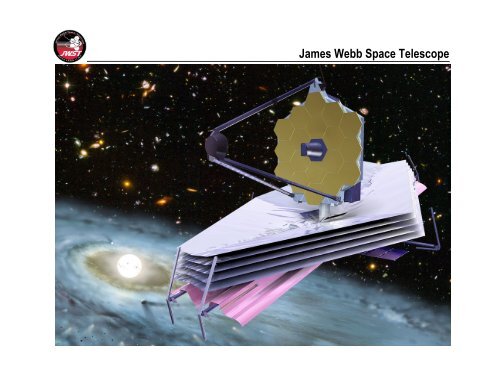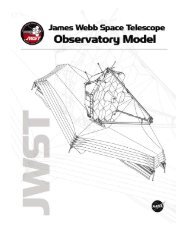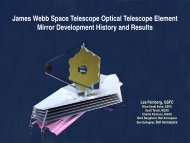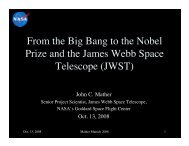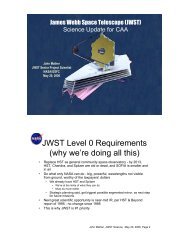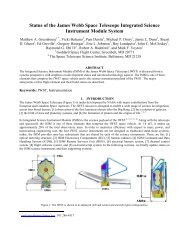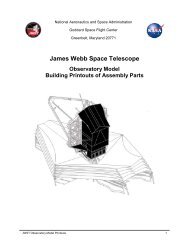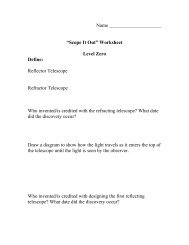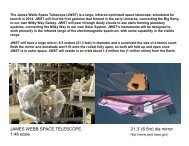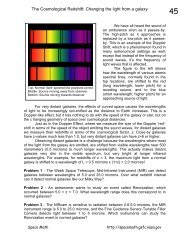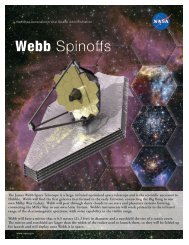JWST litho-j - James Webb Space Telescope - NASA
JWST litho-j - James Webb Space Telescope - NASA
JWST litho-j - James Webb Space Telescope - NASA
Create successful ePaper yourself
Turn your PDF publications into a flip-book with our unique Google optimized e-Paper software.
<strong>James</strong> <strong>Webb</strong> <strong>Space</strong> <strong>Telescope</strong>
First Light: After the Big Bang, the first<br />
galaxies probably formed as groups of<br />
very massive stars. As these stars<br />
finished their lives in explosions called<br />
supernovae, elements such as carbon,<br />
oxygen and iron were formed and blown<br />
into space to seed future generations of<br />
stars. <strong>JWST</strong> will find and study the First<br />
Light Objects.<br />
Image: WMAP Science Team, <strong>NASA</strong>/GSFC<br />
Galaxy Assembly: Large galaxies are<br />
assembled through the merging together<br />
of smaller ones. <strong>JWST</strong> will observe<br />
millions of galaxies at all stages of<br />
development with broad wavelength<br />
coverage and Hubble-like image quality.<br />
The result will be a complete picture of<br />
galaxy assembly from the epoch of First<br />
Light through the present.<br />
Image: Beckwith et al., STScI<br />
The Birthplaces of Stars: Stars and<br />
planetary systems form within nearby<br />
dust clouds, which hide the details of<br />
this process from view. <strong>JWST</strong> –<br />
observing in infrared light that can<br />
penetrate these dusty shrouds – will<br />
reveal the environments within these<br />
stellar nurseries and the conditions for<br />
formation of planetary systems.<br />
Image: M. McCaughrean, M. Andersen, AIP/ESO<br />
<strong>James</strong> <strong>Webb</strong> <strong>Space</strong> <strong>Telescope</strong><br />
The <strong>JWST</strong> Science Mission<br />
The launch of the <strong>James</strong> <strong>Webb</strong> <strong>Space</strong> <strong>Telescope</strong> (<strong>JWST</strong>) will be a giant step forward in the human quest to understand our place in the Universe. With its infrared-optimized<br />
telescope cooled to tens of degrees above absolute zero, hanging in the darkness of space far from Earth at L2, <strong>JWST</strong> will examine every phase of our history: from the first<br />
luminous glows after the Big Bang, to the formation of solar systems capable of supporting life on planets like Earth, to the evolution of our own Solar System. <strong>JWST</strong> will be the<br />
premier space observatory for astronomers worldwide, extending the tantalizing discoveries of the Hubble <strong>Space</strong> <strong>Telescope</strong>, the Spitzer <strong>Space</strong> <strong>Telescope</strong>, and giant groundbased<br />
telescopes.<br />
Mission Concept<br />
To enable scientific discoveries, <strong>JWST</strong> will have a large 6.5-meter primary mirror, passively<br />
cooled to about 45K by a sunshield. It will be sensitive to light from 0.6 to 27 micrometers. There<br />
will be four instruments: a near-infrared (IR) camera, near-IR multi-object spectrograph, mid-IR<br />
instrument, and tunable filter imager.<br />
Technology<br />
Innovations for <strong>JWST</strong> include a folding, segmented primary mirror, adjusted to shape after launch;<br />
ultra-lightweight beryllium optics; detectors able to record ex tremely weak signals, microshutters<br />
that enable programmable object selection for the spectrograph; and a cryocooler for cooling the<br />
mid-IR detectors to 7K.<br />
<strong>JWST</strong> Spitzer<br />
Planets and Life: <strong>JWST</strong> will study the<br />
evolution of planetary systems and ways<br />
they could support life. It will explore the<br />
distribution of organic molecules and<br />
water in our own Solar System; identify<br />
planetary footprints around other stars;<br />
image young planets in nearby systems;<br />
and study the atmospheres of planets as<br />
they transit parent stars.<br />
Images: <strong>JWST</strong>: G. Rieke, Univ. of Arizona; Spitzer: K.<br />
Stapelfeldt, JPL-Caltech<br />
Mission Status<br />
Long-lead items, such as the beryllium mirror segments and science instruments, are under<br />
construction. All mission enabling technologies will be demonstrated by January 2007. Ex ternal<br />
review committees have confirmed the Project’s estimates for the plans, schedules, and budget.<br />
Launch is planned for 2013.<br />
Par tner s<br />
<strong>JWST</strong> is an international collaboration among <strong>NASA</strong>, the European <strong>Space</strong> Agency, and the<br />
Canadian <strong>Space</strong> Agency. The Goddard <strong>Space</strong> Flight Center manages the development effort. The<br />
prime contractor is Northrop Grumman <strong>Space</strong> Technologies. The <strong>Space</strong> <strong>Telescope</strong> Science<br />
Institute will operate <strong>JWST</strong>.<br />
Cover art: Illustration of <strong>JWST</strong> courtesy Northrop Grumman. Artist’s representation of a solar system in formation around the star Fomalhaut; © David A. Hardy/www.astroart.org/PPARC.


